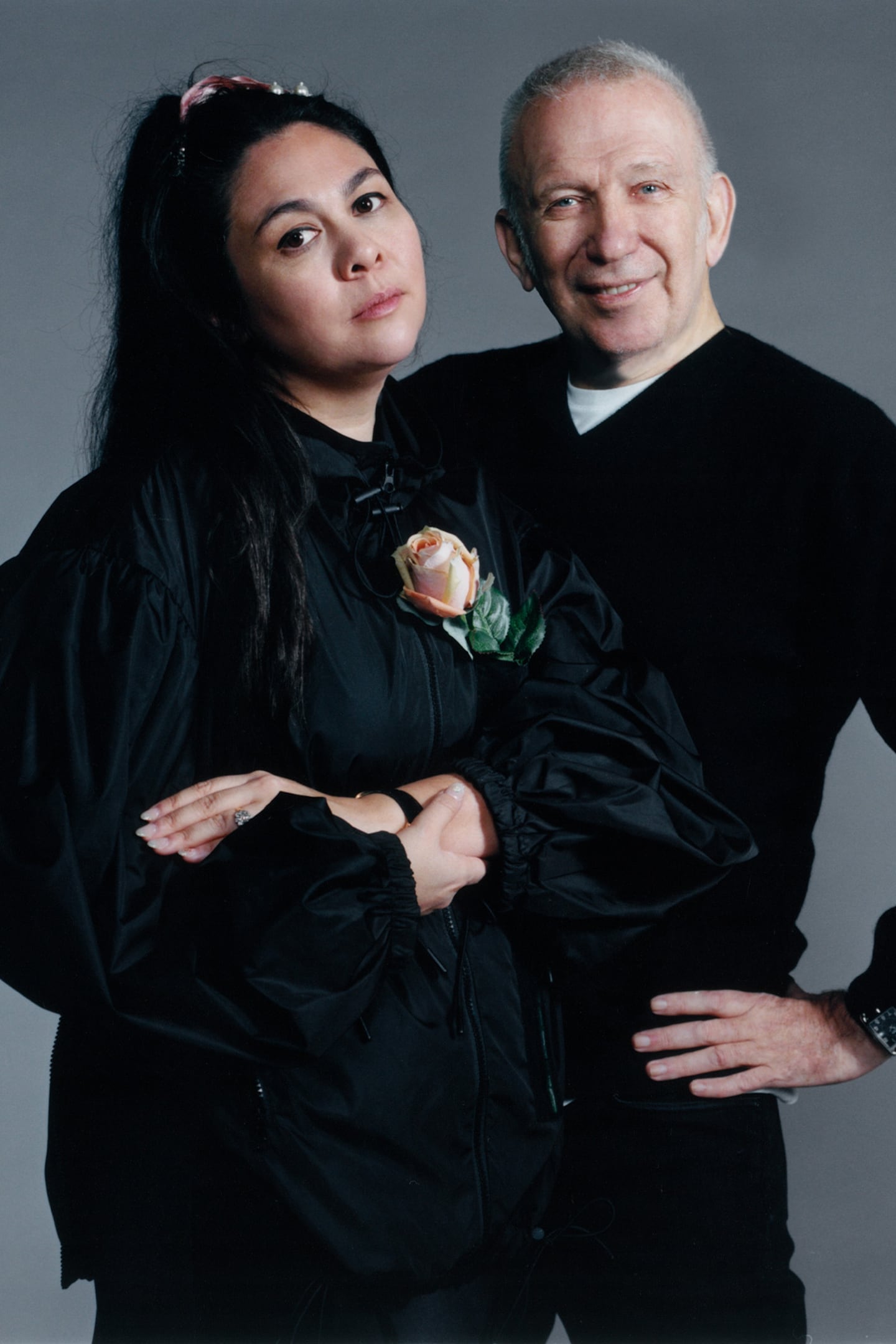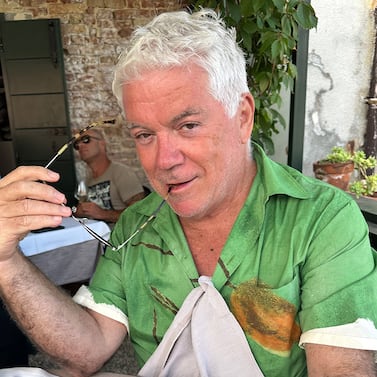
The Business of Fashion
Agenda-setting intelligence, analysis and advice for the global fashion community.

Agenda-setting intelligence, analysis and advice for the global fashion community.

When Simone Rocha was a fashion-obsessed teen working for her designer dad, John, in Dublin, the name Jean Paul Gaultier evoked a grab-bag of associations: powder pink, satin, a conical bra, a corset-shaped perfume bottle packed in an aluminium tin.
It speaks volumes about how far she’s come in her career that eight months ago, Gaultier invited her to be the new guest designer for the remarkable project he initiated when he retired from fashion with his Spring 2020 couture collection. Ever since, he has chosen a different designer each season to interpret his legacy as they saw fit. “It’s a bit pretentious,” Gaultier says bashfully, “because it means I feel I have enough codes and enough style that others can be inspired by it, or break it, or do what they want.” But so far, his idea has been dazzlingly vindicated by the likes of Glenn Martens and Haider Ackerman, suggesting a bottomless well of inspiration. Wednesday afternoon in Paris sees Rocha, the sixth guest, offer her own JPG Redux.
A couple of days earlier, she’s in the Gaultier atelier fitting model Guinevere Van Seenus in an ethereal froth of balletic tulle. It’s anchored by straps and harnesses, a kind of glittering bondage that echoes the fetishistic elements that are a shared feature of Gaultier and Rocha’s work. She calls me over to show me the belt with the rhinestoned daisy motif that runs under the bodice. Its eyelets are integrated into the design so efficiently that the decorative belt is also fully functional. “IN-CRED-IBLE!” Rocha squeals gleefully. The couture workmanship she now has at her fingertips frequently elicits more squeals, some a-maz-ing!’s, more in-cred-ible!’s. She and stylist Robbie Spencer, her trusty lieutenant, are the proverbial kids in a couture candy store. You can hardly blame them. The anything-is-possible essence of haute couture can have that effect on independent designers like Rocha whose budgets aren’t always compatible with their ambition.
Take, for example, the traditional technique known as pincé. A stately gown in black taffeta has sprouted thousands of fragile stems topped by little flowers which are actually twisted feathers. “We had two men come in with plume options,” Spencer marvels. “Plume specialists!” Rocha asked for them to be dipped in blood red, her signature accent.
ADVERTISEMENT
Et voilà! (She herself doesn’t speak French but she insists everyone has been endlessly lovely with their time and expertise.)
Of course the “kids” took a deep dive in the formidable Gaultier archives. They looked at everything, couture and ready-to-wear, and they called in hundreds of looks, more than any of the other guests apparently. Rocha had her favourites: the outfits Gaultier designed for “Le Defilé,” a 1985 collaboration with dancer Régine Chopinot; a couture show from Spring 98 called “The Age of Enlightenment;” and the epochal ready-to-wear collection “Tatouage,” which is an incredible three decades old this year. One of my favourite fashion shows ever, it continues to fascinate fans such as fkaTwigs, who scours the Internet for precious pieces. “I’m also obsessed,” says Rocha. “We really wanted to pay homage.” Gaultier usually opened his shows with an outfit which highlighted his tailoring skills, often in a pinstripe. Rocha’s homage opens her show with a look cut from silver and gold organza threaded with metal and handpainted with motifs from “Tatouage.” “Beneath it, it has a pannier in body mesh which holds up the skirt so it almost becomes this idea of perverted tailoring.”
Gaultier remembers John Rocha, with his distinctive mane of hair, from the 80s. He became interested in John’s daughter when he saw what she was doing in London, a city that is as close to his heart as ever. He wanted to bring some of that energy to Paris. “Simone’s work was more feminine, more romantic than what I did, but in a way that was still open. Irish and Chinese – it’s the culture that makes you create things differently.” He was particularly impressed by her take on one of his own favourites, the Perfecto jacket. She mutated it with an hourglass shape and voluminous sleeves. “I would never have thought to do it like that,” he says.
But it’s not so much different points of view as unexpected affinities which seem to have defined Rocha’s encounter with Gaultier’s couture lexicon. She says after the initial announcement, there were sceptics who foresaw friction, rather than fusion. In fact, it’s been the reverse. “Every piece really feels like me, but also feels very much in conversation with Mr Gaultier, which has been fabulous,” says Rocha. There’s an interesting dialogue, for instance, in the pieces based on hand-crocheted lace from Rocha’s home country. Gaultier used it often in his own collections, and it has always been fundamental to Rocha. But here, in one instance at least, she treats it with a degree of iconoclasm that would have done Jean Paul himself proud. “I knew I wanted to work with fragile, feminine intangible fabrics, but they needed something else hard running through them. This idea of the aluminium, the perfume can, became the root of the whole thing.”
Hence a dress in antique Irish lace which has been lacquered in resin then dipped twice in metal to create a filigree-ed carapace that opens up like a clam so the model can step into it. Lace armour, a paradox. “Very much my vocabulary,” Rocha confirms. She has also stripped the show space in Gaultier HQ on Rue St Martin back to its bare bones, taking down the drapes, covering the floor with sheets of metal so the room is unrecognisable. “I always wanted all this beauty to be with something industrial and scientific, and that was what was getting me off even more on the whole experience.” Gaultier knows nothing of any of this. He may meet with his chosen designer once or twice, but after that, he absents himself from every aspect of their creative process. “I want the surprise,” he insists.
Will he be surprised by Rocha’s wedding dress, the traditional couture show closer? It’s in Chantilly lace, so far so traditional, but Rocha has insisted on catching the lace off the loom before it can be trimmed, so it looks like it is artfully disintegrating. “The lace almost becomes its own embroidery,” she explains. “I wanted to go back to this idea of things in their purest, rawest form.”
That intention manifests in her collection’s most startling disruption. Close your eyes, picture iconic Gaultier, and I bet you’re projecting a cone bra. Rochas does that with one dress in a bottle green taffeta cut from a single bolt of cloth found in the archives. (If someone orders it, the fabric will have to be rewoven, and at the moment, no one is quite sure what mill it originally came from.) Rocha honours its specialness by equipping the dress with the conical breast cups that are, for her – and a million others - the Gaultier-ism that she connects to most, “physically, emotionally, sensitively … just being a woman, and having breasts.” But elsewhere, she twists that cone bra to her own pagan purposes by turning it into a thorn. It punctuates a lot of her looks. In calico, not satin, to boot. The audacity! “When I started to see these looks yesterday on the girls, some who I’ve known and worked with for years, I started thinking of all my early collections and how I felt as a brand new person in London showing this subversive idea of femininity that came completely from my gut, and I actually had that feeling again yesterday, for the first time in a long while. It has been such a breath of fresh air.”
That sentiment is certainly enough to make you wonder what Rocha hopes will follow on from the unique opportunity Gaultier has given her. After a decade of hard-won independence, she’s clearly ready for a next step. “My business has always felt like a bit of a cult, and I’ve always felt very comfortable there. But it’s been very good for me to be in a different environment. It’s brought back an energy, a bit of hunger. I’ll be taking back to my own collection a big appreciation for what we do, but it’s also going to be more ambitious. Whether that’s a good or a bad thing…”
Rocha pauses, uncertain for a second. Then, “I’d like to do a perfume, if anyone’s offering.” She could scarcely wish for a better role model, a greater inspiration in the heady world of designer fragrance than Jean Paul Gaultier. It was, after all, where her story with him started.
0 of 37
Rocha, known for her romantic creations imbued with a subversive take on femininity, will present her interpretation of Jean Paul Gaultier’s work in January 2024 during Paris Couture Week.
The London-based designer is expanding into menswear with a collection that fuses strength and fragility, writes Tim Blanks.
BoF Editor-at-Large Tim Blanks connects with the designer to discuss her Spring/Summer 2021 collection — and how the pandemic changed her creative process.

Tim Blanks is Editor-at-Large at The Business of Fashion. He is based in London and covers designers, fashion weeks and fashion’s creative class.
From where aspirational customers are spending to Kering’s challenges and Richemont’s fashion revival, BoF’s editor-in-chief shares key takeaways from conversations with industry insiders in London, Milan and Paris.
BoF editor-at-large Tim Blanks and Imran Amed, BoF founder and editor-in-chief, look back at the key moments of fashion month, from Seán McGirr’s debut at Alexander McQueen to Chemena Kamali’s first collection for Chloé.
Anthony Vaccarello staged a surprise show to launch a collection of gorgeously languid men’s tailoring, writes Tim Blanks.
BoF’s editors pick the best shows of the Autumn/Winter 2024 season.